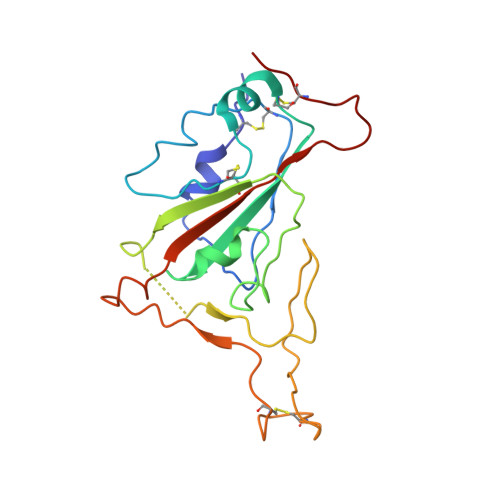A novel nanobody broadly neutralizes SARS-CoV-2 via induction of spike trimer dimers conformation.
Yang, Y., Zhang, J., Zhang, S., Zhang, C., Shen, C., Song, S., Wang, Y., Peng, Y., Gong, X., Dai, J., Xie, C., Khrustaleva, T.A., Khrustalev, V.V., Huo, Y., Lu, D., Yao, D., Zhao, J., Liu, Y., Lu, H.(2024) Exploration (Beijing) 4: 20230086-20230086
- PubMed: 38939869
- DOI: https://doi.org/10.1002/EXP.20230086
- Primary Citation of Related Structures:
8JYS - PubMed Abstract:
The ongoing mutations of the SARS-CoV-2 pose serious challenges to the efficacy of the available antiviral drugs, and new drugs with fantastic efficacy are always deserved investigation. Here, a nanobody called IBT-CoV144 is reported, which exhibits broad neutralizing activity against SARS-CoV-2 by inducing the conformation of spike trimer dimers. IBT-CoV144 was isolated from an immunized alpaca using the RBD of wild-type SARS-CoV-2, and it showed strong cross-reactive binding and neutralizing potency against diverse SARS-CoV-2 variants, including Omicron subvariants. Moreover, the prophylactically and therapeutically intranasal administration of IBT-CoV144 confers fantastic protective efficacy against the challenge of Omicron BA.1 variant in BALB/c mice model. The structure analysis of the complex between spike (S) protein, conducted using Cryo-EM, revealed a special conformation known as the trimer dimers. This conformation is formed by two trimers, with six RBDs in the "up" state and bound by six VHHs. IBT-CoV144 binds to the lateral region of the RBD on the S protein, facilitating the aggregation of S proteins. This aggregation results in steric hindrance, which disrupts the recognition of the virus by ACE2 on host cells. The discovery of IBT-CoV144 will provide valuable insights for the development of advanced therapeutics and the design of next-generation vaccines.
Organizational Affiliation:
Shenzhen Key Laboratory of Pathogen and Immunity Shenzhen Clinical Research Center for infectious disease Shenzhen Third People's Hospital Second Hospital Affiliated to Southern University of Science and Technology Shenzhen China.















